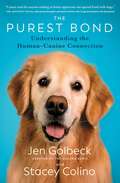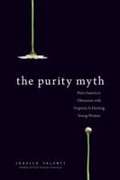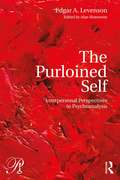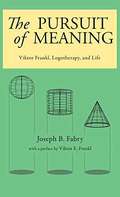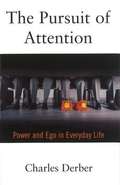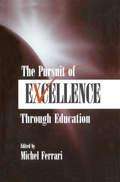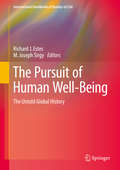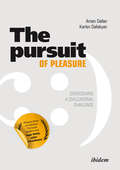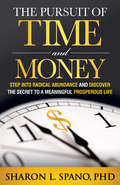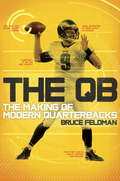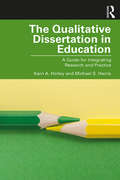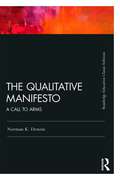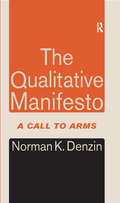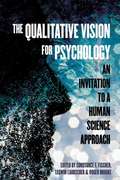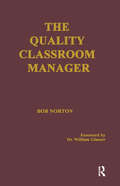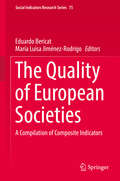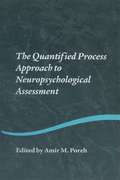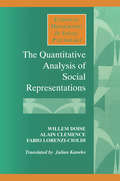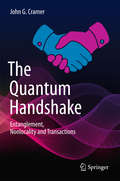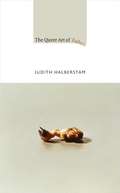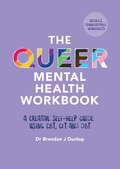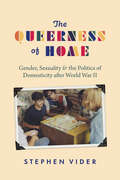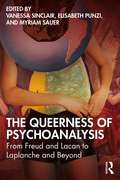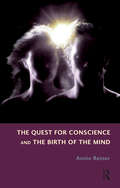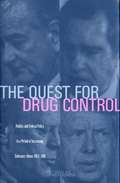- Table View
- List View
The Purest Bond: Understanding the Human–Canine Connection
by Stacey Colino Jen GolbeckA feel-good, comprehensive exploration of the profound bond between humans and dogs from Jen Golbeck, the &“internet&’s dog mom&” behind the massive social media platform The Golden Ratio, and Stacey Colino, an award-winning science writer.Dogs have been considered people&’s best friend for thousands of years, but never has the relationship between humans and their canine companions been as vitally important as it is today. With all of the seismic shifts in today&’s world, rates of anxiety and depression have been skyrocketing, and people have been turning to their dogs for solace and stability. Amidst these dire realities, something wonderful has taken shape. In the United States alone, dog adoptions doubled during the COVID-19 pandemic. As people have brought furry friends into their lives for the first time or seized this opportunity to deepen the connections they already have, they are looking to understand how owning a dog can change their lives. Now, The Purest Bond explores the benefits our dogs can have on our physical, emotional, cognitive, and social well-being, often without our realizing it. Weaving together groundbreaking research and touching real-life stories, The Purest Bond explores not just the social benefits of owning a dog but the science of how dogs improve our emotional and physical health, mental acuity, and our ability to focus and absorb information. Most importantly, they remind us of what&’s right in the world—love, trust, affection, playtime, fresh air, and sunshine—even when so much feels wrong.
The Purity Myth: How America's Obsession with Virginity Is Hurting Young Women
by Jessica ValentiThe United States is obsessed with virginity -- from the media to schools to government agencies. In The Purity Myth, Jessica Valenti argues that the country's intense focus on chastity is damaging to young women. Through in-depth cultural and social analysis, Valenti reveals that powerful messaging on both extremes -- ranging from abstinence-only curriculum to "Girls Gone Wild" infomercials -- place a young woman's worth entirely on her sexuality. Morals are therefore linked purely to sexual behavior, rather than values like honesty, kindness, and altruism. Valenti sheds light on the value -- and hypocrisy -- around the notion that girls remain virgins until they're married by putting into context the historical question of purity, modern abstinence-only education, pornography, and public punishments for those who dare to have sex. The Purity Myth presents a revolutionary argument that girls and women are overly valued for their sexuality, as well as solutions for a future without a damaging emphasis on virginity.
The Purloined Self: Interpersonal Perspectives in Psychoanalysis (Psychoanalysis in a New Key Book Series)
by Alan Slomowitz Edgar A. LevensonThe Purloined Self: Interpersonal Perspectives in Psychoanalysis brings together nineteen essays in updated form, still as relevant, witty and informative today as when the book originally published. Edgar Levenson is a key figure in the development of Interpersonal psychoanalysis and his ideas remain influential. This book covers his seminal writing on theoretical topics such as models of psychoanalysis, Harry Stack Sullivan's theories, and the nature of change, as well as his more familiar focus on practical analytic topics such as transference, supervision, and the use of the self in psychoanalytic clinical work. The content ranges from more technical articles on psychoanalysis and general systems theory, the holographic dimensions of psychoanalytic change; on to issues of metapsychology; and then to articles devoted to examining the nuances of the therapeutic praxis. The general thrust of the book is in the Interpersonal tradition and is a major contribution to a contemporary elaboration of post-Sullivanian Interpersonalism, and of the two-person model of psychoanalysis that has come to permeate the entire field. With a new foreword by Donnel Stern, himself a major name in current Interpersonal analysis, this book gives a comprehensive overview of Levenson's work, and its continued relevance in contemporary psychoanalytic thought. The Purloined Self is highly readable: the author's witty essayist style and original perspective on its material has made it appealing across a wide range of readerships. It will appeal to psychoanalysts and psychoanalytic psychotherapists as well as undergraduate and advanced postgraduate students in these fields.
The Pursuit Of Meaning: Viktor Frankl, Logotherapy, And Life
by Viktor E. Frankl Joseph B. FabryContains the essence of the logotherapeutic writings of Viktor Frankl, who noted that many readers report that they understand some parts of logotherapy for the first time after reading this book. Fabry wrote in the introduction: Many older therapies place responsibility for our difficulties on our early upbringing. Logotherapy is "education to responsibility." Outside influences are important but not all-determining. Within limitations we have a say about who we are and who we want to become. We need never let ourselves be reduced to helpless victims. Consequently, logotherapy-unlike therapies that aim at equilibrium by adjusting patients to society-does not see a tensionless life as a therapeutic goal. Tension is part of living as a human being in a human society. To remain healthy, the unhealthy tensions of body and psyche are to be avoided. But the healthy tension of the spirit strengthens our spiritual muscles. The healthiest tension is between what we are and what we have the vision of growing toward, or, to use Frankl's favorite phrase, "the tension between being and meaning" (Psychotherapy and Existentialism, p. 10). The struggle for meaning is not easy. Life does not owe us pleasure; it does offer us meaning. Mental health does not come to those who demand happiness but to those who find meanings; to them happiness comes as a side product. "It must ensue" noted Frankl. "It cannot be pursued" (Unconscious God, p. 85). Logotherapy maintains and restores mental health by providing a sound view of the human being and the world as we know it. It draws on the huge reservoir of health stored in our specifically human dimension-our creativity, our capacity to love, our reaching out to others, our desire to be useful, our ability to orient to goals, and our will to meaning. Logophilosophy emphasizes what is right with us, what we like about ourselves, our accomplishments, and our peak experiences. It also considers the qualities we dislike so we may change them, our failures so we can learn from them, our abysses so we may lift ourselves up, knowing that peaks exist and can be reached.
The Pursuit of Attention Power and Ego in Everyday Life (Second Edition)
by Charles DerberIn this book, Charles Derber argues that there is a general lack of social support in today's America, one which causes people to vie hungrily for attention. This book analyses the pursuit of attention in conversation--as well as in politics and celebrity culture--and demonstrates the ultimate importance of gender, class, and racial differences in competing for attention.
The Pursuit of Excellence Through Education (Educational Psychology Series)
by Michel FerrariAlthough specific definitions may change over time, few goals are considered more important to education than the pursuit of academic excellence. There are many different viewpoints on this issue today among educational psychologists and other social scientists. One particularly glaring fault line in the debate divides those who emphasize developing individual learning and those who focus on promoting cultural and institutional reform. These two perspectives are rarely addressed in a single volume. In this book, well-known theorists and researchers present a range of perspectives on how to promote excellence in education. This allows those who stress transformation of educational practice and those who emphasize individual abilities to speak to each, and invites readers to jointly consider the arguments for both positions, or for some synthesis of the two. The point is to consider how these two divergent viewpoints can be reconciled, or simply coordinated, in an effort to benefit both students and society at large. The main thesis is that excellence can be fostered without sacrificing equity, both of which are fundamental tenets of a democratic education. The issues addressed in this book have implications and relevance for school reform efforts and across the fields of educational psychology, curriculum and instruction, philosophy of education, and educational leadership. The volume provides a unique source for students and teachers in various disciplines who want to gain a broader and more integrated view of the nature and development of excellence through education.
The Pursuit of Human Well-Being
by Richard J. Estes M. Joseph SirgyThis handbook informs the reader about how much progress we, the human race, have made in enhancing the quality of life on this planet. Many skeptics focus on how the quality of life has deteriorated over the course of human history, particularly given World War II and its aftermath. This handbook provides a positive perspective on the history of well-being. Quality of life, as documented by scientists worldwide, has significantly improved. Nevertheless, one sees more improvements in well-being in some regions of the world than in others. Why? This handbook documents the progress of well-being in the various world regions as well as the differences in those regions. The broad questions that the handbook addresses include: - What does well-being mean? - How do different philosophical and religious traditions interpret the concept of well-being within their own context? - Has well-being remained the same over different historical epochs and for different regions and subregions of the world? - In which areas of human development have we been most successful in advancing individual and collective well-being? In which sectors has the attainment of well-being proven most difficult? - How does well-being differ within and between different populations groups that, for a variety of socially created reasons, have been the most disadvantaged (e. g. , children, the aged, women, the poor, racial, ethnic, and sexual minorities)?
The Pursuit of Pleasure: Overcoming a Civilizational Challenge
by Arsen Dallan Karlen DallakyanThis important book unveils how the pleasure principle has taken humanity hostage to the powers of branding and consumerism, steering our most basic desires. Radically re-evaluating the notion of pleasure and arguing for a deep societal change, it shows the way to a new humanist culture.
The Pursuit of Time and Money: Step into Radical Abundance and Discover the Secret to a Meaningful Prosperous Life
by Sharon L. SpanoThe Pursuit of Time and Money explores the relationship between time and money and how those hidden dimensions impact perspectives and choices. The goal is to help people in business transform their relationship with time and money so they can let go of fear and scarcity and experience a more meaningful and prosperous experience of life. Sharon Spano explores the paradox of time and money from a human developmental lens that supports people in transformational change.
The QB
by Bruce FeldmanWith unparalleled access to Heisman Trophy-winning phenom Johnny Manziel, Bruce Feldman has written a modern-day tale about the making of the next superstars in football's most important position: the quarterback. In the world of modern football, with NFL teams worth more than a billion dollars, no position defines a franchise like the quarterback. The QB is the story of a year in the making of those star players, and of the most significant year in QB development in sport's history... with the meteoric rise of various quarterback gurus finally coming to light. George Whitfield, profiled in the New Yorker and called the "Quarterback Whisperer," gets a regular spot on ESPN's College GameDay, Trent Dilfer, former Super Bowl quarterback, starts his own qb business, Steve Clarkson, another qb maker, gets profiled on 60 minutes, among many others. It is also the year 5'10" Russell Wilson wins the Super Bowl and for the first time in over 60 years a sub-6-foot QB, Johnny Manziel, gets drafted in the first round, forcing NFL power brokers to re-examine how they look at the position--and the game. To tell the story of all that goes on to create the perfect quarterback, bestselling author Bruce Feldman gained unique access to "Johnny Football" (that's Johnny Manziel), George Whitfield and many other players in what has become a specialized and high-stakes business. In the past decade the boom of the private quarterback-coach business, with its pageant-world-for-boys vibe, has changed the position and the game. The QB tells the story of the interlocking paths of the most fascinating characters involved in this secretive world, examining how advanced analysis has taken root in football. Manziel's portrait is the most intimate look at him yet, detailing all his talents and antics. His guru is a man who has come to be known for making QBs--George Whitfield, unparalleled in the business. And then there is Trent Dilfer, the quarterback who never could get to the superstar level, despite winning the Super Bowl. He is the Salieri to Manziel's Mozart. There is the computer/brain analysis company trying to quantify how playmakers think, the biomechanics expert who saved Drew Brees's career, and many more fascinating behind-the-scenes looks into this world. Never before has the game so relied on the development of the quarterback. In The QB, the stories of these men illustrate how high the stakes of the quarterback's game really are, taking readers on a compelling journey into the heart of America's beloved game.
The Qualitative Dissertation in Education: A Guide for Integrating Research and Practice
by Karri A. Holley Michael S. HarrisThe Qualitative Dissertation in Education focuses on the experiences of students pursuing a doctorate in education and writing a qualitative dissertation. The literature on qualitative research has grown substantially over the past 25 years, but methods books often fail to consider the unique situations and resources available to students pursuing a professional doctorate. This book examines the entirety of the dissertation experience, walking readers through the process with examples and guidelines. The structure of the book outlines each chapter of the dissertation as well as the necessary steps to start and complete the dissertation, such as working with a faculty chair and committee, developing a peer support group, and organizing literature. Not only does the book cover each stage of the dissertation process, it also provides practical guidance on topics such as productivity, with exercises and resources to help students overcome obstacles and make progress in their writing. The Qualitative Dissertation in Education provides a foundation to understand both the basics of qualitative research and the expectations of the EdD dissertation.
The Qualitative Manifesto: A Call to Arms
by Norman K. DenzinNow issued as part of the Routledge Education Classic Edition series, The Qualitative Manifesto provides a "call to arms" for researchers from the leading figure in the qualitative research community, Norman Denzin. Denzin asks for a research tradition engaged in social justice, sensitive to identity and indigenous concerns, brave to risk presentation in forms beyond traditional academic writing, and committed to teaching this to their students and colleagues. A new preface text by the author reflects on the changes in research, society and in social justice since the publication of the original edition. Denzin looks to the past, present and future of the field, underlining the continuing importance of this brief, provocative book.
The Qualitative Manifesto: A Call to Arms
by Norman K. DenzinNow issued as part of the Routledge Education Classic Edition series, A Qualitative Manifesto provides a "call to arms" for researchers from the leading figure in the qualitative research commnunity, Norman Denzin. Denzin asks for a research tradition engaged in social justice, sensitive to identity and indigenous concerns, brave to risk presentation in forms beyond traditional academic writing, and committed to teaching this to their students and colleagues. A new preface text by the author reflects on the changes in research, society and in social justice since the publication of the original edition. Denzin looks to the past, present and future of the field, underlining the continuing importance of this brief, provocative book.
The Qualitative Vision for Psychology: An Invitation to a Human Science Approach
by Leswin Laubscher Roger Brooke Constance Fischer<p>This volume, edited by three leading proponents and practitioners of human science psychology, serves as an invitation to readers new to this approach while also renewing that invitation to those who have long embraced and advanced research in the field from this perspective. It is a timely and important invitation. In 2009, the American Psychological Association declared psychology to be a core STEM (science, technology, engineering, mathematics) discipline and advocated the teaching and practice of psychology with this natural science understanding in mind, but in 2014 further reaffirmed alternative methods by adding a new journal, Qualitative Psychology. The varied essays in this volume, certainly, bolster the view that a purely STEM-centered vision would ignore much about the very experience of being human. <p>In fact, it would be dangerous to rely solely on the methods of the natural sciences to study human beings, who operate in the realm of meanings, lived experience, and complex and complicated relationships with self and others. We create societies and belief systems, orient ourselves in time, experience beauty and pain. The Qualitative Vision for Psychology: An Invitation to a Human Science Approach argues that because we have aspects that are distinctly and uniquely human--we are not rats, hydrogen, or rocks, for example--this necessitates a distinctly human science, one that regards persons as humans rather than objects of study. The laws and formulas of the natural sciences simply do not take into account that particularly human way of being in the world. <p>There are few comprehensive books on psychology conceived as a human science, even though it has a long history with roots in phenomenology, existentialism, psychoanalysis, humanistic psychology, and hermeneutics. In recent years, as these essays discuss, the field has been transformed through its contact with feminism, critical historical analysis, and deconstruction, and it has continued to examine new challenges. Further, we see here its specific applicability to issues as diverse as empathy, cultural history, apartheid, sexual assault, fetishes, and our natural environment.</p>
The Quality Classroom Manager
by Robert C. NortonDrawing upon thirty-two years of extensive school work (including classroom teaching, school administrator, principal, District Curricula Director responsible for change, school psychologist, and Director of Special Education and presently teaching at the University of Wisconsin, La Crosse), the principals of control theory/reality therapy and Dr. William Deming's philosophy on quality management, Bob Norton created this "how-to" text to effectively achieve quality classroom management.
The Quality of European Societies: A Compilation of Composite Indicators (Social Indicators Research Series #75)
by Eduardo Bericat María Luisa Jiménez-RodrigoThis volume presents a compilation of composite indicators created in order to measure important aspects of the quality of European societies. It examines three main questions: do Europeans live in good societies and enjoy good lives; are European societies becoming better as time passes, or is their quality slowly deteriorating; is the quality of life of Europe’s citizens improving over time or is it gradually and irrecoverably getting worse. The volume uses a precise and rigorous system of information to answer these questions and to assess the current situation and monitor the quality of European societies. It describes and discusses fourteen key domains, and per chapter, presents five rankings of EU countries based on composite indicators, which are used as one of the best instruments social science has to synthesize a large amount of information, and they are especially well suited to measure multidimensional social phenomena. The new System of Indices on the Quality of European Societies (SIQES) presented in this volume offers a very broad and rich empirical overview of more than 70 social composite indicators and their nearly 300 dimensions. One of the key findings coming out from the SIQES is that, according to the societal quality of European countries, there exist five different “Europes” inside Europe.
The Quantified Process Approach to Neuropsychological Assessment (Studies on Neuropsychology, Neurology and Cognition)
by Amir M. PorehSince the late 1800s psychologists have been interested in discerning the strategies subjects employ to solve psychological tests (Piaget, 1928, Werner, 1940, Gesell, 1941). Much of this work, however, has relied on qualitative observations. In the 1970s, Edith Kaplan adopted this approach to the analysis of standardized neuropsychological measures. Unlike her predecessors, Dr. Kaplan and her colleagues emphasized the application of modern behavioral neurology to the analysis of the test data. Her approach was later termed the Boston Process Approach to neuropsychological assessment. While Edith Kaplan's work generates a great deal of enthusiasm, the qualitative nature of her analyses did not allow for its adoption by mainstream neuropsychologists. However, in recent years this limitation has begun to be addressed. Clinicians and researchers have developed new methodologies for quantifying the Boston Process Approach, leading to the emergence of a new field, which is collectively termed the Quantified Process Approach. Quantified Process Approach to Neuropsychological Assessment outlines the rationale for the emergence of this new approach and reviews the state of the art research literature and up to date clinical applications as they pertain to the evaluation of neuropsychiatric, head injured, and learning disabled patients. When available, norms and scoring forms are included in the appendices.
The Quantitative Analysis of Social Representations (European Monographs in Social Psychology)
by Fabio Lorenzi-Cioldi Alain Clemence Willem DoiseDesigned for undergraduate and postgraduate courses in sociology and social psychology, this textbook looks at the quantitative methodology of social representations research, using empirical and graphical illustrations and data tables.
The Quantum Handshake
by John G. CramerThis book shines bright light into the dim recesses of quantum theory, where the mysteries of entanglement, nonlocality, and wave collapse have motivated some to conjure up multiple universes, and others to adopt a "shut up and calculate" mentality. After an extensive and accessible introduction to quantum mechanics and its history, the author turns attention to his transactional model. Using a quantum handshake between normal and time-reversed waves, this model provides a clear visual picture explaining the baffling experimental results that flow daily from the quantum physics laboratories of the world. To demonstrate its powerful simplicity, the transactional model is applied to a collection of counter-intuitive experiments and conceptual problems.
The Queer Art of Failure
by Judith HalberstamThe Queer Art of Failure is about finding alternatives--to conventional understandings of success in a heteronormative, capitalist society; to academic disciplines that confirm what is already known according to approved methods of knowing; and to cultural criticism that claims to break new ground but cleaves to conventional archives. Judith Halberstam proposes "low theory" as a mode of thinking and writing that operates at many different levels at once. Low theory is derived from eccentric archives. It runs the risk of not being taken seriously. It entails a willingness to fail and to lose one's way, to pursue difficult questions about complicity, and to find counterintuitive forms of resistance. Tacking back and forth between high theory and low theory, high culture and low culture, Halberstam looks for the unexpected and subversive in popular culture, avant-garde performance, and queer art. She pays particular attention to animated children's films, revealing narratives filled with unexpected encounters between the childish, the transformative, and the queer. Failure sometimes offers more creative, cooperative, and surprising ways of being in the world, even as it forces us to face the dark side of life, love, and libido.
The Queer Mental Health Workbook: A Creative Self-Help Guide Using CBT, CFT and DBT
by Dr. Brendan Dunlop'A privilege to read, a pleasure to endorse' PROFESSOR TANYA BYRON'This book completely bowled me over' DOMINIC DAVIES'A super comprehensive book' MEG-JOHN BARKERTo be queer is to feel different - a felt sense that you don't fit in. This can be alienating and difficult and lead to mental health challenges and lower wellbeing throughout life. Using a range of therapeutic approaches, this comprehensive, down-to-earth self-help workbook is designed to be your personal mental health resource. It is filled with techniques and activities you can read, tailor and 'pick and mix' to improve your wellbeing as a queer person, at your pace.The workbook is split into two sections - the first part focusses on laying the groundwork by exploring identity, psychological wellbeing, and mental health experiences in order to situate mental health challenges in context and improve overall mental health. The second half hones in on ideas and techniques applicable to specific challenges and situations. It explores difficult topics such as anxiety, low self-esteem, eating disorders, self-harm, suicidal ideation, shame, trauma, substance abuse, sleep, and low mood, all whilst maintaining a focus on your needs as a queer individual.Empowering and reassuring, and written by an experienced queer mental health practitioner, this one-of-a-kind workbook will help you to flourish as a queer person and begin to overcome any challenge.
The Queerness of Home: Gender, Sexuality, and the Politics of Domesticity after World War II
by Stephen ViderVider uncovers how LGBTQ people reshaped domestic life in the postwar United States. From the Stonewall riots to the protests of ACT UP, histories of queer and trans politics have almost exclusively centered on public activism. In The Queerness of Home, Stephen Vider turns the focus inward, showing that the intimacy of domestic space has been equally crucial to the history of postwar LGBTQ life. Beginning in the 1940s, LGBTQ activists looked increasingly to the home as a site of connection, care, and cultural inclusion. They struggled against the conventions of marriage, challenged the gendered codes of everyday labor, reimagined domestic architecture, and contested the racial and class boundaries of kinship and belonging. Retelling LGBTQ history from the inside out, Vider reveals the surprising ways that the home became, and remains, a charged space in battles for social and economic justice, making it clear that LGBTQ people not only realized new forms of community and culture for themselves—they remade the possibilities of home life for everyone.
The Queerness of Psychoanalysis: From Freud and Lacan to Laplanche and Beyond
by Vanessa Sinclair Elisabeth Punzi Myriam SauerThe Queerness of Psychoanalysis: From Freud and Lacan to Laplanche and Beyond is an exploration of psychoanalysis’ often complicated and fraught history with thinking about queerness, as well as its multifaceted heritage.Throughout the chapters, the contributors write about psychoanalysis’ relationship with queerness, the ways in which queerness is represented in the psychoanalytic archive, and how that archive endures in the present and creates various disruptive effects both within and beyond the clinic. Each chapter from the global cohort of contributors approaches queerness from a different angle: they consider the literary aspects of queerness’ presence in the analytic world; the clinical complexities of working with queer and trans people; metapsychological inclusion and exclusion of queerness, and many other subjects. Taken together these contributions constitute a decisive intervention into the psychoanalytic canon. They are an unabashed demand for accepting and furthering the representation and inclusion of queer, and in particular trans, people within psychoanalysis. It is a call for action to utilize and deepen psychoanalysis’ enormous explicatory powers and bring together voices that have so far been denied a unity of expression, while critically reevaluating psychoanalysis’ historical relationship to queerness. Each chapter proposes different ways of thinking and writing psychoanalytically, with many of the papers queering the format and forms of expression commonly found in academic writing, through their use of dialogues, conversations, or other experimental forms of writing.Written almost exclusively by analysts, scholars, and activists who identify as trans and/or queer, this important volume puts theory into practice by centering queer and trans voices.
The Quest for Conscience and the Birth of the Mind
by Annie ReinerThis book offers a new perspective on conscience as an as yet unrealized human potential, but a potential toward which human beings are naturally driven. A distinction is made between a "mature" or "healthy" conscience - a "conscience capable of maturation" - and the classical notion of the superego; it also postulates that the two may represent two separate lines of development. Conscience is seen to be inseparable from consciousness; the development of a mature conscience is seen to have its foundation in the development of a true or authentic self, while the classical notion of the superego is viewed as an often pathological manifestation of this natural mental potential. Theological ideas are relevant to any discussion of morality, conscience and guilt. Freud's and Bion's perspectives on religion are closely examined, revealing fundamental differences in their views of the mind. The author incorporates the metaphysical perspective central to Bion's concept of "O" as fundamental to an understanding of the development of a healthy conscience.
The Quest for Drug Control: Politics and Federal Policy in a Period of Increasing Substance Abuse, 1963-1981
by David F. Musto Pamela KorsmeyerBetween 1960 and 1980 various administrations attempted to deal with a rising tide of illicit drug use that was unprecedented in U. S. history. This valuable book provides a close look at the politics and bureaucracy of drug control policy during those years, showing how they changed during the presidencies of Johnson, Nixon, Ford, and Carter and how much current federal drug-control policies owe to those earlier efforts. David F. Musto, M. D. , and Pamela Korsmeyer base their analysis on a unique collection of 5,000 pages of White House documents from the period, all of which are included on a searchable CD-ROM that accompanies the book. These documents reveal the intense debates that took place over drug policy. They show, for example, that staffers and cabinet officers who were charged with narcotics policy were often influenced by the cultural currents of their times, and when the public reacted in an extreme fashion to rising drug use, officials were disinclined to adopt modified policies that might have been more realistic. Musto and Korsmeyer's investigation into the decision-making processes that shaped past drug control efforts in the United States provides essential background as creative approaches to the drug problem are sought for the future.
